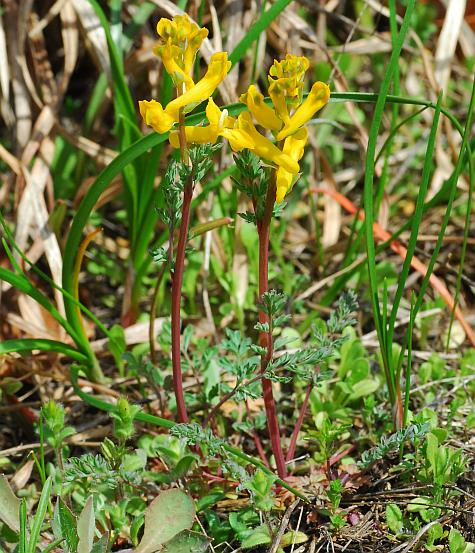Corydalis micrantha ssp. micrantha
Small-Flowered Corydalis

Native
CC = 4
CW = 5
MOC = 55
© SRTurner
Corydalis micrantha ssp. micranthaSmall-Flowered Corydalis | |
 |
Native CC = 4 CW = 5 MOC = 55 |
© SRTurner |
|
Family - Fumariaceae Habit - Taprooted annual or biennial forb. Plants green or more commonly gray and glaucous. Stem - Loosely to strongly ascending, to 35 cm, often from a spreading base.
Leaves - Basal and alternate, 2-3 times compound or lobed. Basal and lower stem leaves with the petiole 2-6 cm long, the upper leaves mostly sessile. Leaf blades 1-7 cm long, with mostly 5 or 7 pinnae, these deeply several-lobed, the ultimate segments linear or narrowly to broadly oblong-elliptic, lanceolate, or occasionally obovate.
Inflorescences - Usually extending only slightly past the foliage, those with open flowers racemes with 5-20-flowers, those with cleistogamous flowers clusters or short racemes with 1-6-flowers. Flower stalks 2-6 mm long, ascending at flowering and fruiting.
Flowers - Corollas pale yellow to yellow, the upper outer petal 11-15 mm long, the spur 4-6 mm long, straight or nearly so, slightly rounded and expanded at the tip, the concave apical portion with a low, irregular crest or occasionally merely keeled.
Fruits - Capsules 10-15 mm long, relatively stout, straight or curved, glabrous, not appearing mealy. Seeds 1.4-1.6 mm long, the surface minutely pebbled (best observed with magnification), the rounded rim lacking a marginal ridge.
Flowering - April - June. Habitat - Glades, upland prairies, savannas, dry upland forest openings, streambanks, crop fields, railroads, roadsides, and open disturbed areas. Origin - Native to the U.S. Lookalikes - Other species of Corydalis. Other info. - This species is distinguished from the somewhat more common C. flavula by flowers which are larger and have spurs which are straight rather than curved downward. It is the second most common Corydalis in Missouri after C. flavula. It is found across most of Missouri, but it somewhat more common on the western side of the state. Its range within the continental U.S. is mostly within the Midwest. The photos above depict ssp. micrantha, which is the more common of the two subspecies found in Missouri. It is characterized by inflorescences which do not rise much above the foliage and by shorter, stouter fruits. It does not seem to show the same strong preference for sandy soils as ssp. australis. In general, species of Corydalis require close attention to detail for positive identification. Important factors to note are the size of the flowers, flower stalks, and seeds. Photographs taken near Bona Glade Natural Area, Dade County, MO, 4-6-2019 (SRTurner). |